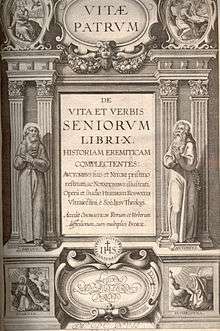Vitae Patrum
The Vitae Patrum (literally Lives of the Fathers, also called Lives of the Desert Fathers) is an encyclopedia of hagiographical writings on the Desert Fathers and Desert Mothers of early Christianity. The bulk of the original texts date from the third and fourth centuries.[1][2] The Lives that were originally written in Greek were translated into Latin between the fourth and the seventh century. An Italian vernacular translation was made by Dominican friar Domenico Cavalca from Pisa at the beginning of the fourteenth century.

A printed edition, edited by the Jesuit Heribert Rosweyde, was printed by Balthazar Moret in 1615. The book is a significant part of the much broader work, Acta Sanctorum.[3]
The Vitae Patrum is based on extensive research by Rosweyde into all the available literature he could find on the early desert monastics. Hippolyte Delehaye described the work as "the epic of the origins of monasticism in Egypt and Syria, an epic unsurpassed in interest and grandeur." In the thirteenth century, a version of Vitae Patrum had been translated into Latin. It was such a popular book that numerous versions and editions were published, with extensive changes and variations in the stories. Rosweyde based his book on twenty-three different versions of those earlier books, studying, dating, and classifying all the different versions and changes.[3]
Rosweyde's Vitae Patrum consists of ten books. Book I has the lives of sixteen saints under the title Vitae virorum and eleven saints under the title Vitae mulierum, beginning with St. Paul the Hermit and St. Anthony of the Desert, and including women saints such as Saint Mary the Harlot. Books II, Historia monachorum, and III, Verba seniorum (Sayings of the Elders), are attributed to Rufinus, who was later found to be only their translator. Book IV is a compilation of writings by Sulpicius Severus and John Cassian. Book V is another collection of Verba seniorum from Latin and Greek by Pelagius.[3]
Book VI and Book VII are further collections of Verba seniorum (Sayings of the Elders) by unknown Greek authors translated by John the subdeacon, possibly Pope John III, and by Paschasius. Book VIII is a text that was previously known as The Paradise of Heraclides, but which Rosweyde attributed to its real author, Palladius, and titled the Lausiac History. Book IX is De Vitis Patrum by Theodoret. Book X is The Spiritual Meadow of Moschus. Rosweyde wrote an introduction to each book.[3]
See also
- Apophthegmata Patrum
- Asceticon
- Bollandist
- Ethiopic Collectio Monastica
Notes
- Anne Leader (30 December 2011). The Badia of Florence: Art and Observance in a Renaissance Monastery. Indiana University Press. p. 140. ISBN 978-0-253-35567-6. Retrieved 9 August 2012.
- "Vitae Patrum". Retrieved 11 August 2012.
- Hippolyte Delehaye (1922). The work of the Bollandists through three centuries, 1615-1915. Princeton University Press. pp. 17–20. Retrieved 10 August 2012.
External links
- Société des Bollandistes
- Monika Studer, Summary of Latin and German Vitaspatrum Transmission
- English translation of Vitae Patrum by Benedict Baker, site maintained by The Revd Benedict Baker, in Powys, Wales
- The Vitas Patrum - The Lives of the Fathers, University of Rochester, Robbins Library Digital Projects, Susanna Greer Fein (Editor), David Raybin (Translator) & Jan Ziolkowski (Translator), from the Complete Harley 2253 Manuscript, Volume 1, 2015, retrieved February 1, 2020 (Latin-English)